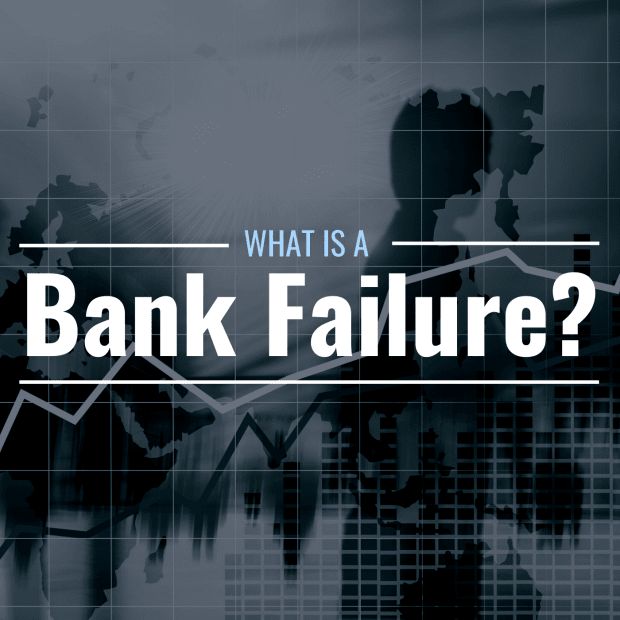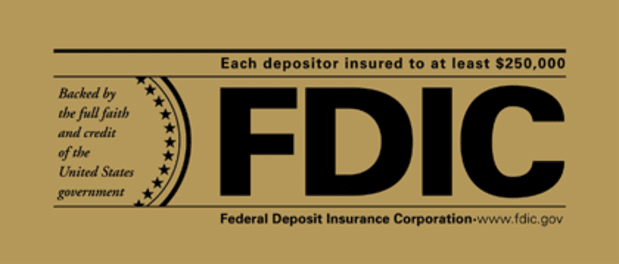
Funtap from Getty Images; Canva
You hear your bank is in trouble, and you immediately start to panic.
“Will I lose my money?” You wonder, breathlessly.
You envision yourself suddenly unable to pay for your groceries, or buy gas, or fund your child’s college tuition, so you rush online or jump in your car to withdraw your deposits, only to find that the server has crashed or a line snakes around the bank with other customers thinking the same thing.
Through these actions, you’re contributing to a bank run—and believe it or not, you’re actually making matters worse for the failed bank, since you are reducing its liquid assets even further.
Enter the Federal Deposit Insurance Corporation (FDIC). By its mandate, it protects consumers of failed banks by insuring their banking deposits. While most, but not every bank in the United States is FDIC insured (check the FDIC’s BankFind tool to see if yours is), a requirement for those who are is to display this sign outside of their window:

So, if you see this sign outside your bank teller window, you know you will get your money back even in the event that your bank fails.
The standard FDIC insurance amount is up to $250,000, and it covers checking accounts, savings accounts, money market deposit accounts, and certificates of deposit.
But in the aftermath of the banking crisis of 2023, when Silicon Valley Bank (SVB), Signature Bank, and First Republic Bank failed, the FDIC promised to make all of their depositors whole, even those with accounts that exceeded the $250,000 insurance limit.
They did this in an effort to restore confidence in the banking system. After all, the FDIC was created during the Great Depression, a time of great turmoil, when thousands of banks failed, and ever since its formation, the FDIC has ensured that not a penny of insured deposits has ever been lost.
What Causes a Bank Failure?
A bank fails when a federal or state regulatory agency shuts it down. Failures happen when a bank cannot meet its obligations to its depositors or has taken on too much risk in its loan portfolio. The failed bank is then seized by the FDIC or another regulating authority, such as a state agency, and placed under receivership.
If its debts can be resolved, the bank is usually sold to another entity. If the bank is dissolved, the FDIC liquidates its assets by settling debts and depository claims, even those over and above the insured limit. Banks pay premiums to the FDIC to receive this insurance coverage, so no taxpayer “bailouts” are involved in this process.
The FDIC’s stated goal is to return insured deposits within two days of a bank’s failure, and the announcement of a bank failure usually happens on a Friday evening. Up until a few years ago, most banks were not open on the weekends, giving the FDIC time to turn the bank around so it could reopen on Monday.
What Happens When a Bank Fails?
When a bank fails, the FDIC takes several actions:
- It sets up a “bridge bank,” a temporary entity that continues operations until the failed bank is acquired.
- It notifies each depositor in writing.
- It creates an auction to arrange a sale of the failed bank’s assets.
- It freezes all deposit accounts so it can pay depositors directly for their deposit balances to the insured limit.
If a depositor exceeds the insured limit, they can file a claim for the excess funds. In the event the bank is acquired by a healthier bank, the odds are good that nothing will be lost.Outstanding checks made after the bank’s failure are returned unpaid, and it is the customer’s responsibility to make other funds available to creditors.
After the failed bank is acquired by another bank, the new bank must take the following actions:
- It must make every effort to make the public aware of its acquisition, through the news media, town hall meetings, flyers, and other alerts.
- It must send written notice to the old bank’s depositors, alerting them of the change.
- It must ensure that all direct deposits and Social Security payments are appropriately redirected.
- It must accept checks and deposit slips from the failed bank for a short period.
What Was the Biggest Bank Failure in U.S. History?
With assets of $309 billion, the collapse of Washington Mutual during the Financial Crisis of 2007–2008 marked the biggest bank failure in American history. The self-proclaimed “Wal-Mart of Banking,” WaMu was a savings and loan association headquartered in Seattle that had more than half of its assets in housing loans—single-family, adjustable-rate, or subprime.
It had aggressively expanded operations into the subprime mortgage lending sphere in the early 2000s at a time when the Federal Reserve was raising interest rates. Since the rates on these mortgages were tied to prevailing interest rates, they, too, shot up. Millions of subprime customers suddenly found themselves unable to pay their monthly mortgages and defaulted on their loans, unleashing a string of falling dominoes that would be result in the near-insolvency of the nation’s biggest government sponsored mortgage providers, Fannie Mae and Freddie Mac, as well as the toppling of global investment banks, like Bear Stearns, valued at $350.4 billion.
When an even bigger investment bank, Lehman Brothers, valued at $600 billion, threatened to combust, President Obama deemed it “too big to fail” and Congress rushed to provide a $700 billion “bailout bill” to stabilize consumers, banks, and global financial markets.
Washington Mutual experienced a 9-day bank run, where depositors withdrew $16.7 billion, and it was placed under the receivership of the FDIC on September 25, 2008. It declared bankruptcy the next day and was eventually taken over by JPMorgan Chase.
How Many Bank Failures Were There in 2023?
Three regional banks were seized by the FDIC during the banking crisis of 2023:
Silicon Valley Bank (SVB)
SVB was based in California and had high-net-worth clients including Airbnb, Pinterest, and Roku. It experienced a $42 billion bank run in one day in March, 2023 on the heels of a credit downgrade and billion-dollar earnings loss.
Signature Bank
A favorite of the Trump family, the New York-based Signature Bank also had a niche business that catered to the ultra-rich: It helped finance the Trump International Golf Course in Florida, for example. It was also under investigation by the U.S. Justice Department for failing to disclose what it knew about cryptocurrency exchange FTX’s unlawful business dealings. This troubled bank experienced a $10 billion bank run less than 48 hours after SVB failed.
First Republic Bank
Eleven of the country’s biggest banks—including JPMorgan Chase—banded together to try to save First Republic, but not even a $30 billion lifeline could keep it afloat. The bank, which was headquartered in San Francisco, catered to tech startups and had a staggering loan-to-deposit ratio of 111%. Its bond reserves suffered from interest-rate risk when the Fed raised the fed funds rate by more than 5% in a little over a year, between March 2022 and May 2023.
Why Were Bank Failures Common During the Great Depression?
The Great Depression took place in the early days of the Federal Reserve before the U.S. left the gold standard or engaged in open market operations. This severely limited the amount of liquidity in the financial system; in turn, smaller-sized banks had proliferated in the country between the Civil War and the 1920s. Size would become their problem; since they were limited to having just one branch, they could not diversify their loan portfolios and were vulnerable to sudden changes in demand. Nearly 4,000 banks failed from the banking crisis in 1933 alone.







